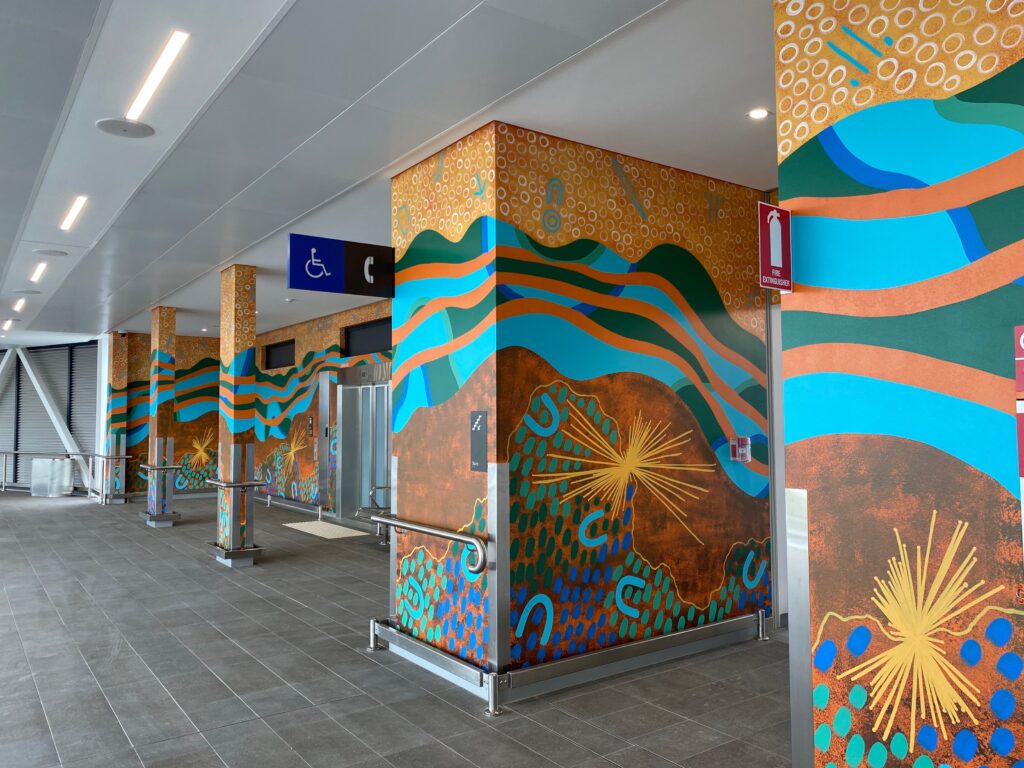Perth Airport in Australia has curated a soundscape and indigenous art installation in its skybridge to honor local Aboriginal Australian Noongar families and their stories.
The skybridge, which will open on October 9 with the new Metronet Airport Line, will link the station to the airport’s terminals. It provides a raised and sheltered walkway across the main terminal car park, providing direct access to the T1 forecourt. It has been designed to provide clear orientation and wayfinding with views across the terminal precinct. The modular bridge was installed in 12 sections, has three entry points, and includes energy-efficient walkway travellators to speed up pedestrian transit between the airport and train station.
Perth Airport sits on the traditional lands of the Whadjuk people of the Noongar Nation. Therefore, the airport engaged with local Noongar families to create a soundscape that can be heard throughout the bridge. The soundscape provides reflections on the significance of the Derbarl Yerrigan (the Swan River) and Wadjak Boodja (Whadjuk Country) and the family members’ personal experiences of this place. Perth Airport’s Aboriginal Partnership Group has also given the bridge the appropriate name Worl Bidi (‘worl’ meaning sky and ‘bidi’ meaning path) to honor the connections the families have with the land.
The soundscape was designed to form a short audio journey through the Swan River region – moving through different areas of the land and waters at different times of the day and night. An entire journey for the listener would have them transported from one end of the Swan River to the other over the course of a day, while encountering differing weather conditions, all the while being spoken to by a traditional custodian who shares their stories and viewpoints from a cultural perspective.
The form of the river journey is made up of the following six sub-sections – ‘The Mouth of the River’, ‘Into the Wetlands’, ‘New Day’s Song’, ‘The Heat of the Day’ and ‘To the Lakes and Ocean’. ‘The Mouth of the River’ formulates a journey from the rapids at the northern end of the river to the calmer waters downstream toward Perth. Listeners are introduced to the narrative guides and are exposed to the sounds of some of the endemic natural life that the region is known for, such as carnaby’s cockatoos, galahs and black swans. In the ‘Into the Wetlands’ section, the stronger northern waters slow to a shallower section of the river where life in the wetlands can be heard, including frogs, birds and insect life calls. In ‘New Day’s Song’, the night turns to early morning, bringing with it the birdsong of magpies, butcherbirds and currawongs. Next, ‘The Heat of the Day’ portion features cicadas and crickets with ravens, cockatoos and small bush birds such as the willie wagtail. ‘To the Lakes and Ocean’ represents the afternoon and includes the calls of black swans, curlews and silver gulls. Finally, the ‘night falls’ section is designed to represent the late afternoon and early evening where the calls and hoots of curlews, nightjars and owls echo through the landscape.
Local artists Nani Creative, Jade Dolman and Crispian Warrell from Western Australia were commissioned to produce traditional artwork throughout the bridge that links to the soundscape, the Derbarl Yerrigan/Swan River and Country. Warrell’s artwork, featured on the two travelators, speaks to the story of traveling along the Derbarl Yerrigan and the flora and fauna within Noongar boodjar. Dolman has installed two murals representing the connection to ocean and land. Dolman said, “These murals are about our connection to Boodjar and how important it is to give back to country, when we take. This reciprocal relationship has been practiced by Noongars on this country for thousands of years.”
Kevin Brown, CEO of Perth Airport, said, “The new pedestrian bridge linking Airport Central station with the airport’s terminals provides a seamless connection for passengers arriving at or departing from the airport and combines some incredible art and storytelling. Today, we form part of a modern traveling network – one which connects people across the globe to our home, and we greatly value the responsibility of being the first point of connection to the vibrant and unique cultural heritage of our state’s Aboriginal people for international and interstate visitors.”


